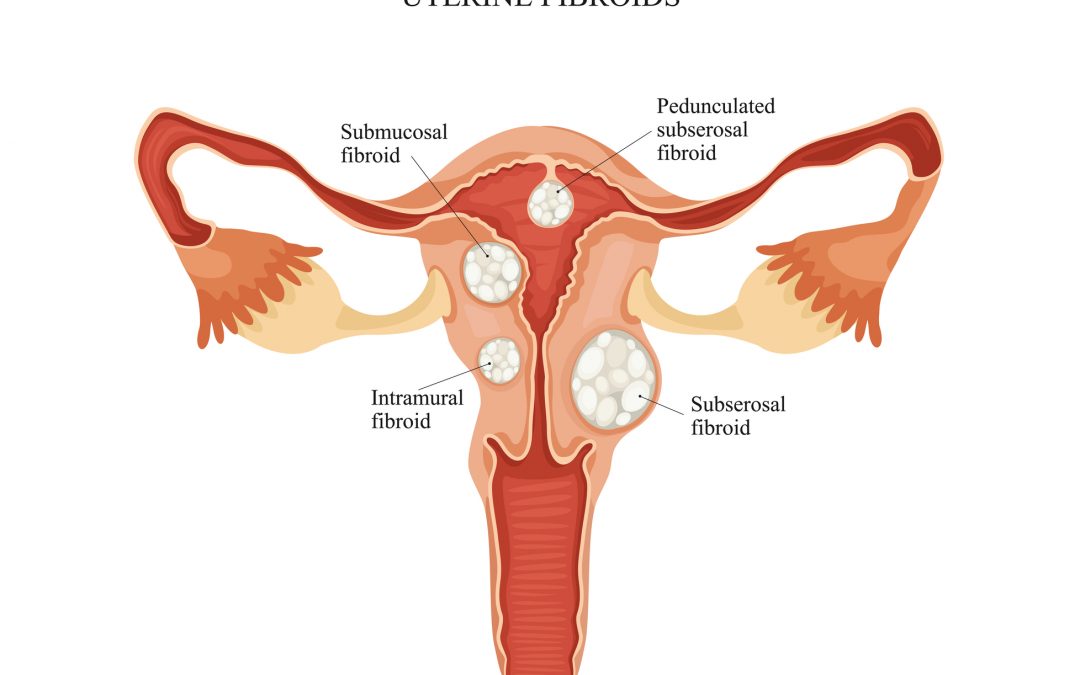As promised, this article is about Uterine Fibroids. They are also referred to as myomas or fibromyomas. The medical word for them is Leiomyomas (Lie-o-my-o-ma). Big Topic. I’l have to do it in two parts because I really want you to have all the available information.
Fibroids are very common. By the age of 50, 80% of a African American women and 70% of Caucasian women will have fibroids. Two thirds of the time these women will not have symptoms and will not seek treatment for their fibroids. As women get older they tend to develop fibroids. Also, women who have no or few children, those who eat a high fat diet, those taking a certain drug called tamoxifen (used to treat breast cancer) and those with a family history are most at risk. What is a fibroid? It is a tumor of the muscle fibers that make up the uterus. Basically, it starts with a damaged muscle cell, this cell then multiples until it forms a noticeable lump in the wall of the uterus. Fibroids get bigger in the presence of estrogen and that is why they usually shrink after menopause and can get bigger when a woman is pregnant. Some reports suggest that taking birth control pills can also make the fibroids get bigger while other reports disagree with this notion. The jury is still out on this one. What causes damage to that one cell? Who knows. Is is diet? Is is smoking? Is it because someone is overweight? Is is alcohol? Is it the hormones and chemicals used to increase food production? I have done surgery on vegetarians, skinny women, women who work out six days a week and women who don’t drink and shop at Whole Foods.
Fibroids are found in three different sections of the uterus. Think of the shape of an avocado after you have sliced it in half and removed the seed. Fibroids can be found near the outer part, right underneath the covering as represented by the avocado skin. They can grow deep in the center of the muscle fibers as represented by the yellow to light green part of the avocado. They are also found close to the lining of the uterus as represented by the part of the avocado that you can see once you throw the seed away. Fibroids that are close to the lining can protrude of even dangle into the uterine cavity. Most women will have more than one fibroid located in all three areas. The fibroids that are found in the cavity tend to be the ones that contribute to heavy bleeding and cause spotting to occur days before or after the menstrual flow. In addition to heavy bleeding, many women report one or more of the following: a constant dull ache in the pelvis, rectal pressure, having to urinate often, pain with defecation and pain with sex.
On the pelvic exam, the gynecologist can feel the fibroids and will usually order a pelvic ultrasound. To get a better look at the inside of the uterus, your doctor may perform a special test which uses dye to trace the shape of the uterine cavity or perform a hysteroscopy (hiss-ter-os-co-py) which uses a small camera to actually look inside the uterine cavity and take pictures. Sometimes, especially if the fibroid is huge, like the size of a cantaloupe or larger, the physician may call for a Cat Scan or an MRI.
I tell my patients, “If the fibroids don’t bother you then don’t bother them”, even if they are large. Unfortunately, in one out of every three women, fibroids cause symptoms. This leads to the discussion of what to do. There are a few things that we have available to help and the one chosen depends on if the women wants to have children and need to keep her uterus. Some women want to keep their uterus even if they are not planning of having children. Some women are not in pain but simply can’t tolerate the heavy bleeding and are in fact, becoming anemic.
If my patient’s complaint is heavy bleeding, then we can start with birth control pills. In the absence of other medical problems, i.e. high blood pressure, diabetes or obesity, birth control pills are safe to take up to age 50. Honestly, birth control pills are not that effective in the face of fibroids, after awhile most women will come back seeking some other kind of remedy. The Mirena IUD (Intra Uterine Device) is another option. This device delivers hormones directly to the uterus and results in less bleeding. If you have a big bulky uterus with lots of fibroids, it can be difficult for the physician to place the IUD and the IUD can get “pushed out” because of the fibroids. Studies have shown that the Mirena IUD does work. Getting insurance coverage can prove challenging however, since the device is only FDA approved as a contraceptive. Avoiding the risks of surgery and taking time off from work may be worth the upfront cost if you have to pay out-of-pocket.
If the pill or the IUD is not an option, an endometrial ablation is another avenue. This procedure, which can be done with different techniques—hot water, hot water in a balloon, freezing, microwave and electricity—simple destroys the lining of the uterus. Think back to the avocado. All bleeding comes from the lining, which is referred to as the endometrium. By simply charring or vaporizing this area we can reduce the amount of blood loss. This procedure will require some kind of anesthesia but women do go home on the same day. I have had a lot of success with the ablation and patients are really happy. Keep in mind that this procedure cannot be used if the uterus is too big, if the shape of the uterus does not allow the instruments to fit properly inside and if there is a large fibroid dangling or pushing into the cavity. Also, it is still surgery. With surgery comes risks. Each technique has it’s own risks but what is common to all the approaches is the risk of poking a hole in the uterus (uterine perforation). In most cases, your doctor simply has to stop the procedure and have you come back in a few weeks to try again, or to try something else. In rare cases, the perforation is not noted and heat is then distributed outside of the uterus…to places like your bowel and bladder. This is rare. Rare.
If bleeding and pain are the culprits then that leaves us with one of the following: hysterectomy, myomectomy, laparoscopic myomectomy, uterine artery embolization and focused ultrasound surgery. Which one is right for you? Which one will preserve your fertility? Will you need a c-section after having the fibroids surgically removed? Which one will affect your sex life? And, if you don’t have a hysterectomy, how long before the fibroids return and once again, leave you wondering what to do?
Part II of this topic will answer these questions, so keep reading.
There you have it, now spread the word!


Thank you Dr. Michael Thomas for bringing up an important point. It is a good idea to keep track of the size of your fibroids with ultrasounds (or CTs). This is important if you are trying to preserve your fertility. As fibroids grow, they do distort (and can destroy) the uterus. Also, if the fibroids are of a certain size, you will no longer be a candidate for some of the less invasive procedures, i.e. laparoscopic and even vaginal approaches. I will expand on this in my next writing.
Dear Juleit M Nevins,
I have fibriod and would want to know what to eat to help me and what I should not do
thank you